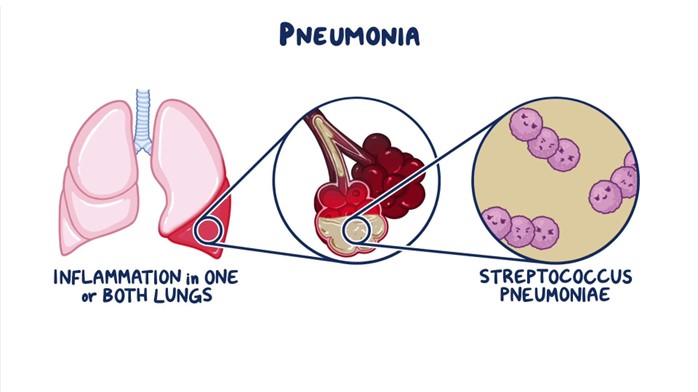In caring for a client who is receiving linezolid IV for nosocomial pneumonia, which assessment finding is most important for the nurse to report to the health care provider?
Yellow-tinged sputum
Nausea and headache
Watery diarrhea
Increased fatigue
The Correct Answer is C
Choice A: Yellow-tinged sputum is not a serious adverse effect of linezolid. It may indicate an infection or inflammation in the respiratory tract, but it does not require immediate attention from the health care provider.
Choice B: Nausea and headache are common side effects of linezolid. They are usually mild and self-limiting, and they can be managed with supportive measures such as hydration, rest, and analgesics.
Choice C: Watery diarrhea is a sign of pseudomembranous colitis, a potentially life-threatening complication of linezolid. It is caused by an overgrowth of Clostridium difficile bacteria in the colon, which produce toxins that damage the intestinal mucosa. It can lead to dehydration, electrolyte imbalance, sepsis, and perforation. The nurse should report this finding to the health care provider immediately and stop the linezolid infusion.
Choice D: Increased fatigue is not a specific or serious adverse effect of linezolid. It may be related to the underlying infection, anemia, or other factors. It does not require urgent intervention from the health care provider.

Nursing Test Bank
Naxlex Comprehensive Predictor Exams
Related Questions
Correct Answer is D
Explanation
Choice A: Increasing oral fluids may help with hydration, but it will not reduce skin flushing caused by lisinopril. Lisinopril is an angiotensin-converting enzyme (ACE. inhibitor that dilates blood vessels and lowers blood pressure. Flushing occurs due to increased blood flow to the skin.
Choice B: Nitroglycerin is a vasodilator that relaxes smooth muscle in blood vessels and reduces chest pain caused by angina. It is not indicated for skin flushing caused by lisinopril. Moreover, nitroglycerin can lower blood pressure further and cause hypotension, headache, dizziness, and fainting.
Choice C: Going to an emergency department is not necessary for skin flushing caused by lisinopril. Flushing is not a sign of an allergic reaction or anaphylaxis, which would require immediate medical attention. Flushing is also not a symptom of a heart attack or stroke, which would present with other signs such as chest pain, shortness of breath, arm numbness, or slurred speech.
Choice D: Reassuring the client that facial flushing is a common side effect of lisinopril is the best action for the nurse to take. Flushing is not harmful or dangerous, and it usually subsides within a few hours. The nurse should explain the mechanism of action of lisinopril and its benefits for lowering blood pressure and preventing angina. The nurse should also advise the client to monitor his blood pressure regularly and report any signs of hypotension, such as dizziness, lightheadedness, or fainting.
Correct Answer is ["B","C","E","F"]
Explanation
Choice A reason: Alcohol consumption will not produce vascular changes is incorrect information. Alcohol consumption can increase blood pressure by causing vasoconstriction, fluid retention, and interference with antihypertensive medications. The nurse should advise the client to limit alcohol intake to no more than one drink per day for women and two drinks per day for men.
Choice B reason: Weight management is promoted by taking daily walks for thirty minutes is correct information. Weight management can lower blood pressure by reducing body fat, improving blood circulation, and enhancing insulin sensitivity. The nurse should advise the client to maintain a healthy weight and engage in moderate physical activity for at least 150 minutes per week.
Choice C reason: Salt substitutes can help with maintaining a healthy diet is correct information. Salt substitutes can reduce sodium intake by replacing sodium chloride with potassium chloride or other minerals. The nurse should advise the client to use salt substitutes sparingly and consult with their healthcare provider before using them if they have kidney disease or take certain medications that affect potassium levels.
Choice D reason: Blood pressure readings should be taken at noontime is incorrect information. Blood pressure readings should be taken at different times of the day, preferably in the morning and evening, to monitor fluctuations and trends. The nurse should advise the client to use a home blood pressure monitor that is accurate and calibrated and follow proper techniques for measuring blood pressure.
Choice E reason: Sodium intake can be regulated by limiting canned foods in the diet is correct information. Sodium intake can increase blood pressure by causing fluid retention and increasing vascular resistance. The nurse should advise the client to limit sodium intake to no more than 2300 mg per day and avoid processed foods that are high in sodium, such as canned foods, soups, sauces, and snacks.
Choice F reason: Uncontrolled hypertension can lead to renal damage is correct information. Uncontrolled hypertension can damage the blood vessels in the kidneys, leading to reduced kidney function and chronic kidney disease. The nurse should advise the client to follow their prescribed treatment plan and monitor their blood pressure regularly.
Whether you are a student looking to ace your exams or a practicing nurse seeking to enhance your expertise , our nursing education contents will empower you with the confidence and competence to make a difference in the lives of patients and become a respected leader in the healthcare field.
Visit Naxlex, invest in your future and unlock endless possibilities with our unparalleled nursing education contents today
Report Wrong Answer on the Current Question
Do you disagree with the answer? If yes, what is your expected answer? Explain.
Kindly be descriptive with the issue you are facing.
